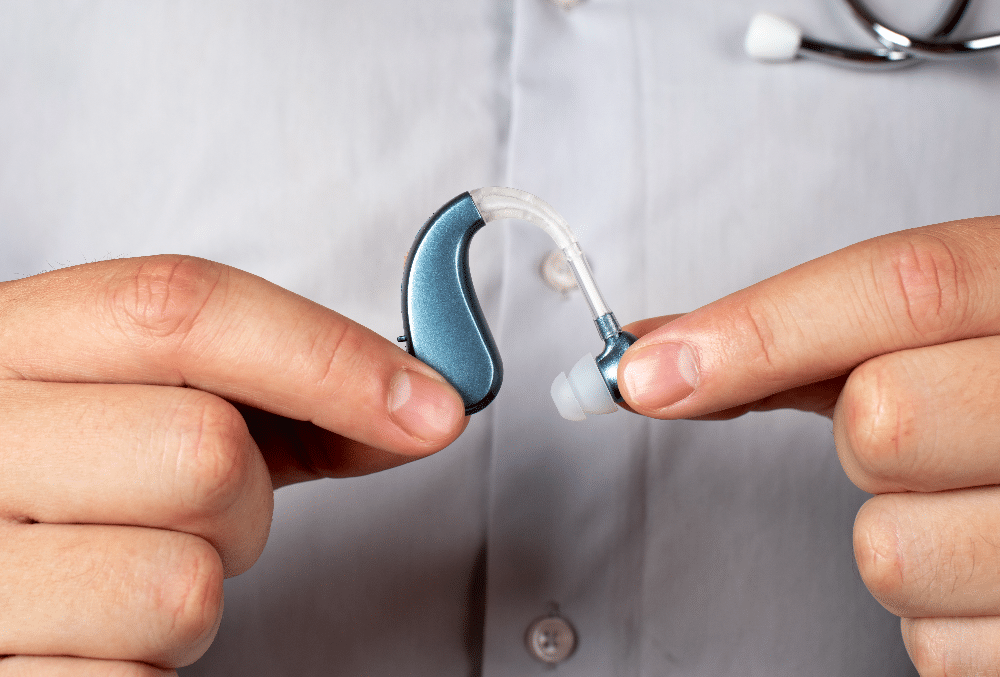That persistent ringing, buzzing, or hissing in your ears — the phantom noise known as tinnitus — can feel like an unwelcome guest that just won’t leave. It can be incredibly frustrating, making it hard to focus, relax, and even sleep. While there’s no one-size-fits-all solution, advancements in hearing aid technology offer a glimmer of hope. Noise-cancelling hearing aids for tinnitus can provide much-needed relief by amplifying the sounds you want to hear and offering features designed to gently soothe those internal noises. This guide will explore how hearing aids can help with tinnitus, discuss key features to consider, and outline other strategies for managing this often-disruptive condition.
Do Hearing Aids Help with Tinnitus?
While hearing aids don’t directly stop the ringing in the ears, they can significantly reduce its impact and improve your overall quality of life. Here’s how:
- Tinnitus-Masking Features: Many modern hearing aids come equipped with tinnitus-masking features. These features generate soothing sounds, such as white noise, nature sounds, or customized tones, which help to mask the perception of tinnitus. By providing a pleasant auditory distraction, these sounds can make the tinnitus less noticeable and intrusive.
- Amplification for Hearing Loss: Often, tinnitus is accompanied by hearing loss. By amplifying external sounds, hearing aids can help you focus on the world around you rather than the internal noise of tinnitus. This can make the tinnitus less noticeable and improve your ability to focus on what you want to do, engage in conversations and enjoy everyday sounds.
- Bluetooth Hearing Aids and Tinnitus Relief Apps: Many advanced hearing aids offer Bluetooth connectivity, allowing you to stream audio from your smartphone or other devices directly to your hearing aids. This can be particularly helpful for managing tinnitus, as you can use tinnitus relief apps or listen to your favorite music or podcasts to mask the phantom noises.

How to Choose the Right Hearing Aid for Tinnitus Relief
Selecting the right hearing aid in the Philippines involves considering various factors to ensure the device effectively addresses your specific needs and preferences. Here are some key features to look for:
1. Sound Processing
Advanced sound processing capabilities are crucial for managing tinnitus. Look for hearing aids that offer features like noise reduction and directional microphones. These features can help filter out background noise and focus on the sounds you want to hear, making it easier to ignore the tinnitus. Signia, a leading hearing aid manufacturer, offers advanced noise reduction technology that can significantly improve speech clarity and reduce the perception of tinnitus in noisy environments.
2. Automatic Adjustments
Hearing aids with automatic adjustments can adapt to different listening environments, ensuring optimal sound quality and tinnitus relief throughout your day. These hearing aids can automatically adjust the volume and sound processing settings based on your surroundings, making it easier to transition from quiet environments to noisy ones without being overwhelmed by tinnitus or external sounds. When choosing hearing aids with this feature, consider your lifestyle and the types of environments you frequent to ensure the automatic adjustments align with your needs.
3. Customisation
Tinnitus is a personal experience, and the most effective management strategies often involve personalized solutions. Look for hearing aids that offer customizable tinnitus masking features. This allows you to adjust the type, intensity, and frequency of the masking sounds to best suit your individual needs and preferences. Some hearing aids even allow you to create your own personalized sound therapy programs.
Other Treatments
While hearing aids can be highly effective in managing tinnitus, they are often just one piece of the puzzle in a broader treatment plan. Other therapies and strategies can complement the use of hearing aids and further enhance tinnitus relief. Think of it as a holistic approach to silencing the phantom noises and reclaiming your auditory well-being.
- Sound Therapy: This involves using external sounds to mask the perception of tinnitus. Imagine creating a soothing soundscape that gently covers the intrusive ringing or buzzing. This can be achieved through various means, such as white noise machines, nature sounds, or even carefully selected music. Sound therapy can be used in conjunction with hearing aids, with some devices offering built-in sound generators, or as a standalone treatment to provide relief in quiet environments.
- Tinnitus Retraining Therapy (TRT): This therapy takes a more comprehensive approach, combining sound therapy with counseling to help you habituate to the tinnitus and reduce its negative impact on your life. TRT aims to retrain your brain to filter out the tinnitus signal, making it less noticeable and bothersome over time. It’s akin to teaching your brain to tune out the unwanted noise, much like you might learn to ignore background chatter in a busy café.
- Cognitive Behavioral Therapy (CBT): While not directly targeting the tinnitus itself, CBT can be incredibly helpful in managing the emotional and psychological distress associated with it. This therapy helps you identify and modify negative thought patterns and behaviors related to your tinnitus, leading to better coping mechanisms and reduced anxiety.
- Stress Relief: Stress can often exacerbate tinnitus, making the phantom noises seem louder and more intrusive. Incorporating stress management techniques into your daily routine can help reduce the intensity and impact of tinnitus. This could involve practicing mindfulness meditation, engaging in deep breathing exercises, or finding solace in activities like yoga or spending time in nature. By managing stress, you can create a calmer internal environment that may help quiet the ringing in your ears.
Beyond Silence: Reclaiming Your Auditory Well-being
While tinnitus can be a persistent challenge, it doesn’t have to control your life. By understanding the condition, exploring the various treatment options, and seeking professional guidance, you can find effective ways to manage tinnitus and rediscover the joy of sound. If you’re considering hearing aids for tinnitus relief, reaching out to a hearing health center can provide personalized recommendations and ensure you find the perfect device for your needs. They can also guide you on other strategies like sound therapy or tinnitus retraining therapy.
Whether through noise-cancelling hearing aids for tinnitus, sound therapy, or other strategies, there is hope for relief and a return to auditory well-being. Don’t let tinnitus silence your world — take the first step towards reclaiming your auditory peace today.








